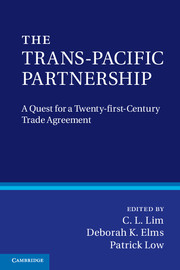Book contents
- Frontmatter
- Contents
- List of Figures and Tables
- Contributors
- Preface
- Acknowledgements
- Disclaimer
- Glossary
- Part I Introduction
- Part II The past: origins of the TPP Agreement
- Part III The present: twenty-first century elements and obstacles
- Part IV The future: high-quality meets regional and global realities
- 15 Achieving a Free Trade Area of the Asia-Pacific
- 16 APEC and the TPP
- 17 Coping with multiple uncertainties
- 18 The TPP
- 19 The TPP in a multilateral world
- Part V The TPP negotiations: the quest for quality
- Index
- References
15 - Achieving a Free Trade Area of the Asia-Pacific
does the TPP present the most attractive path?
Published online by Cambridge University Press: 05 November 2012
- Frontmatter
- Contents
- List of Figures and Tables
- Contributors
- Preface
- Acknowledgements
- Disclaimer
- Glossary
- Part I Introduction
- Part II The past: origins of the TPP Agreement
- Part III The present: twenty-first century elements and obstacles
- Part IV The future: high-quality meets regional and global realities
- 15 Achieving a Free Trade Area of the Asia-Pacific
- 16 APEC and the TPP
- 17 Coping with multiple uncertainties
- 18 The TPP
- 19 The TPP in a multilateral world
- Part V The TPP negotiations: the quest for quality
- Index
- References
Summary
This chapter examines the prospects for the Trans-Pacific Partnership (TPP) to expand into a Free Trade Area of the Asia-Pacific (FTAAP). It does so by comparing the TPP to other potential models for Asian economic integration, and by identifying what factors might enhance or diminish the possibility of the TPP serving as the FTAAP model.
First, the chapter briefly traces the history of the TPP and its linkage to a potential FTAAP. Second, it examines other potential models for regional economic integration and discusses the pros and cons of each option for the major economies in the region. Third, it discusses reasons why the TPP might or might not be the preferred model, identifying important factors playing into this calculus.
The origins of the TPP-FTAAP linkage
The concept of an FTAAP has been bandied about for the past several years. C. Fred Bergsten has been a particularly strong advocate of this idea, espousing the pursuit of the Bogor goals of free trade and investment regimes throughout the Asia-Pacific Economic Cooperation (APEC). APEC initiated a study of the FTAAP concept in 2006, and in 2009 pledged to explore pathways to create an FTAAP. Bergsten’s early writings 3 on the subject assumed the only way an FTAAP could be accomplished would be to take the existing regional FTAs and agreements and combine them into an FTAAP. More recently, however, Bergsten has seized upon the TPP as the basis for an ultimate FTAAP.
- Type
- Chapter
- Information
- The Trans-Pacific PartnershipA Quest for a Twenty-first Century Trade Agreement, pp. 223 - 241Publisher: Cambridge University PressPrint publication year: 2012
References
- 2
- Cited by

